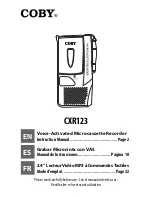
3 – Connections–Control connections
TASCAM DA-98HR
21
WORD SYNC
jacks do
not need to be connected between the DTRS units.
3.3
Control connections
3.3.1
RS-422 connector
This connector is used to connect the DA-98HR to
other controllers or editors which will control the
DA-98HR using the Sony P2 protocol, or a bus pro-
tocol. See 10, “External control” for details.
If you are in doubt about the compatibility of such a
device, please consult TASCAM or your TASCAM
dealer, who will be able to advise you.
The DA-98HR can emulate (through software con-
trol accessed through menu 6) a number of devices
for compatibility with almost any controller.
3.3.2
MIDI connectors (IN , OUT and
THRU)
These standard 5-pin DIN MIDI connectors
are
used to carry MIDI Time Code (MTC) and MIDI
Machine Control (MMC) information between the
DA-98HR and other suitably-equipped units (for
instance, sequencers capable of being synchronized
to MTC, and capable of transmitting MMC
commands).
The MIDI functions are accessed through menu
group 7. See 10.5, “MIDI Machine Control” for full
details.
Note the difference between
MIDI OUT
and
MIDI
THRU
. The
OUT
connector outputs signals which
originate from the DA-98HR. The
THRU
connector
echoes messages received at the
IN
.
3.3.3
Parallel control
Parallel control by and of the DA-98HR is performed
through the
CONTROL I/O
port
. See this section
for details of how to connect other equipment to this
port.
3.4
Connection to other
TASCAM units
By a “TASCAM unit”, we mean another DA-98HR,
a DA-98, a DA-88 or a DA-38 unit, or an optional
remote control unit, or digital mixing console incor-
porating remote control facilities, which may also be
connected in a “chain” with multiple DTRS units.
3.4.1
Multiple DTRS units
Use a TASCAM PW-88S cable when connecting
other units to the
REMOTE/SYNC IN
connector
to the
SYNC OUT
connector
This synchronization cable will carry the internal
synchronization code and the transport signals, etc.
There is no need to make any other connections,
apart from the audio connections (either digital or
analog).
If more than one DTRS unit is to be used, the first
unit in the chain must have its Machine ID set to “1”,
(“0” in the case of DA-88s) and subsequent units
must have their IDs set in order with no gaps in the
numbering sequence. Note that the diagram below
does not show any audio connections.
See 8.2.2, “Setting machine ID” for details of setting
the Machine ID using menu group 3.
NOTE
S
The last unit in the chain must be terminated (a TASCAM
termination plug must be plugged into the
SYNC OUT
of
the last machine in the chain.
Once again, only use TASCAM cables for connection of
equipment to and from the DA-98HR.
The total length of remote/sync cables in the chain should
not exceed 15 m (approximately 50 ft.).
3.4.2
“Indirect” word sync
As mentioned earlier, there is usually no need to use
a word clock when connecting DTRS units together.
There is, however, a special case when it is necessary
to carry external word sync between DTRS units.
This is when a slave DTRS unit is recording digitally
from another digital audio device:
Machine ID 1
(master)
Machine ID 2
(slave 1)
Machine ID 3
(slave 2)
Termination
plug
PW-88S
PW-88S
PUSH
PUSH
PUSH
PUSH
PUSH
Machine ID 1
(master, but
CLOCK set to
WORD)
Termination
plug
PW-88S
IF-88SD
TDIF-1 digital
audio
Digital SDIF-2
device
SDIF-2
Machine ID 2
(slave 1)
digital audio
Word clock signal
















































